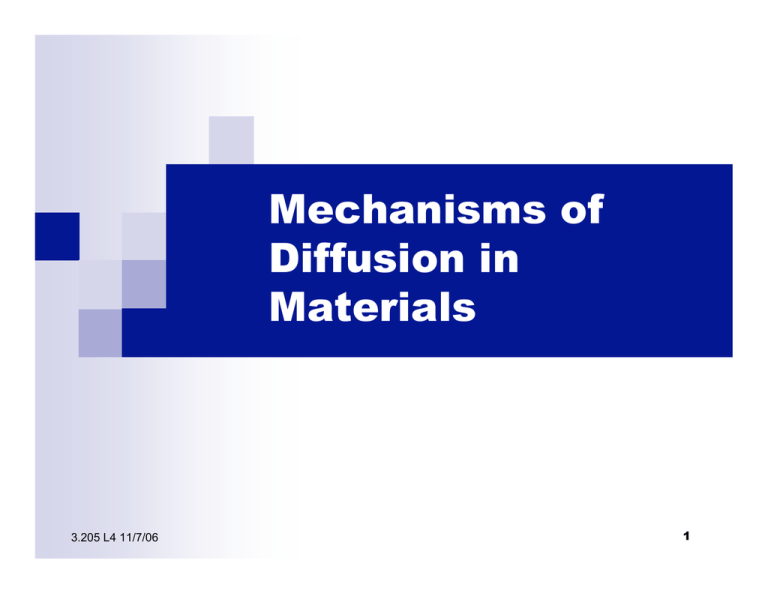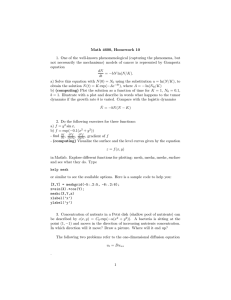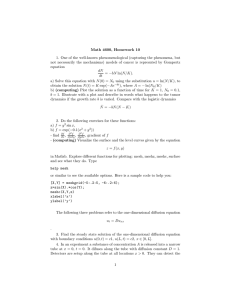Document 13554848
advertisement

Mechanisms of Diffusion in Materials 3.205 L4 11/7/06 1 A final point on interdiffusion… • The composition profiles resulting from inter diffusion are generally constrained by phase equilibria. Consider the an Ir–Re diffusion couple annealed at 2400°C: Equilibrium diagram 3.205 L4 11/7/06 Diffusion couple 2 • Now consider the Os–W system at 2200°C : In this case, a couple initially between pure Os and pure W can form an intermediate phase, σ, in the interdiffusion zone. If σ forms, the resulting composition curve will have two discontinuities. 3.205 L4 11/7/06 3 • Illustration of interphase layer growth in X–Y alloy interdiffusion… Video clip from “Diffusion in solid metal—multiphase system,” V. Ruth (Universität Oldenburg), K. Schaar, J. Thienel, and H.G. Graske (Institut für de Wissenschaftlichen, Göttingen) ©IWF, Gottingen 1986 3.205 L4 11/7/06 4 Atomistic mechanisms for diffusion in crystals • • Given sufficient thermal energy, an atom can move from one site to another in a crystal. Most diffusion in crystals occurs by either the vacancy mechanism or the interstitial mechanism. Figures removed due to copyright restrictions. See Figures 8.2 and 8.7 in Balluffi, Robert W., Samuel M. Allen, and W. Craig Carter. Kinetics of Materials. Hoboken, NJ: J. Wiley & Sons, 2005. ISBN: 0471246891. 3.205 L4 11/7/06 5 Atomistic mechanisms, cont’d • Additional mechanisms include the interstitialcy mechanism in crystals containing significant numbers of self-interstitials (e.g., produced by irradiation); and the reptation mechanism in molten (hence non-crystalline) polymers. Interstialcy 3.205 L4 11/7/06 Reptation 6 Atomistic mechanisms, cont’d • Jumps of vacancies and interstitials are thermally activated, and jumps occur at a jump rate, Γ’, [ #" = $ exp %G ! m ( kT )] Figure removed due to copyright restrictions. See Figure 7.2 in Balluffi, Robert W., Samuel M. Allen, and W. Craig Carter. Kinetics of Materials. Hoboken, NJ: J. Wiley & Sons, 2005. ISBN: 0471246891. ν is an “attempt frequency” typically ~1013 s–1; and Gm is the free energy of migration. The total jump frequency, Γ, is Γ = z Γ’, where z is the coordination number (z = 12 in f.c.c.). 3.205 L4 11/7/06 7 Diffusion and random walks During self-diffusion, vacancies and interstitials execute a random walk among sites in the crystal structure: the trajectories they follow involve a series of discrete jumps, and each jump is uncorrelated with the previous jump. Illustrate the effects of a vacancy executing a random walk in a diffusion couple via Java applet… 3.205 L4 11/7/06 8 Diffusion & random walks, cont’d • Mean-square displacement from a random walk of n jumps each of length r: R 2 = nr 2 and for a random-walking vacancy or interstitial, the self-diffusivity in three-dimensional systems ! is given by: "r 2 D= ! 3.205 L4 11/7/06 6 9 Diffusion & random walks, cont’d • Diffusion in alloys: intrinsic diffusivity and interdiffusivity These can involve correlated jumps and the resulting value of the mean square displacement can be either greater than, or less than, that for self-diffusion. The correlation factor, f, accounts for the extent of correlation, with f = 1 for uncorrelated jumps: R 3.205 L4 11/7/06 ! 2 #r 2 = nr " f and D = f 6 2 10 Self-diffusion of interstitials • Involves only random walk of the interstitial species, and thus "I r 2 z"I# r 2 z$r 2 DI = f= f= exp %GIm ( kT ) &1 6 6 6 [ ] z$r 2 = exp SIm k & exp %H Im ( kT ) 6 [ ] [ ] Note that interstitial motion is uncorrelated, so f = 1. ! 3.205 L4 11/7/06 11 Self-diffusion of vacancies • Involves only random walk of vacancies, and thus "V r 2 z"V# r 2 z$r 2 DV = f= f= exp %GVm ( kT ) &1 6 6 6 [ ] z$r 2 = exp SVm k & exp %H Vm ( kT ) 6 [ ] [ ] Note that vacancy motion is uncorrelated, so f = 1. ! 3.205 L4 11/7/06 12 Self-diffusion of solute atoms via vacancy mechanism • Involves exchange of randomly walking vacancies with the solute atom, A, and thus the atom jump frequency must relate to both the vacancy jump frequency and the probability that a site adjacent to the solute atom is vacant, XV. XV is equal to the equilbrium fraction of vacant sites, XV = exp "GVf ( kT ) = exp SVf k exp "H Vf ( kT ) [ ! 3.205 L4 11/7/06 ] [ ] [ ] 13 Self-diffusion of solute atoms via vacancy mechanism, cont’d Using equations for D and "A = XV "V = XV z"V# Xv z"v r 2 zr 2# DA = f= exp $ GVf + GVm ( kT ) f 6 6 ! zr 2# f m = exp SV + SV k exp $ H Vf + H Vm ( kT ) f 6 [( [( ) ] [( ] ) ) ] The correlation factor, f, for vacancy diffusion in metals is about 0.7 and can be calculated more ! precisely for various specific cases. 3.205 L4 11/7/06 14





